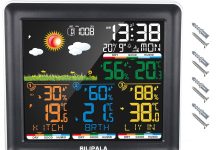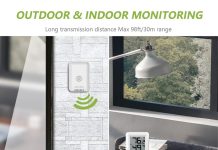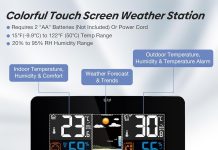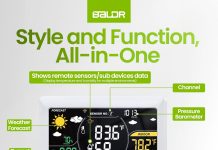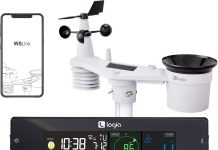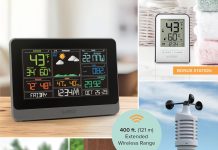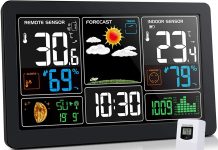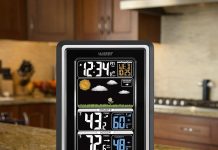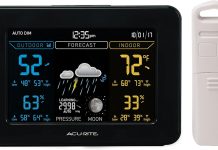Today, we explore the exciting possibilities of integrating a home weather station with smart home devices and systems. With the rise of smart technology, homeowners are seeking ways to make their lives more efficient and convenient. So, is it possible to connect our beloved weather stations to our smart homes? We delve into this question and uncover the potential benefits, challenges, and steps to successfully integrate these two technologies. Get ready to bring a whole new level of intelligence to your living space!
What is a home weather station?
A home weather station is a device or set of devices that allows individuals to gather and monitor weather information directly from their own property. With a home weather station, you can easily track essential weather data such as temperature, humidity, wind speed, and precipitation levels. These devices typically consist of several components, including sensors, a console or display unit, and connectivity options for transmitting data to your computer or smartphone. By having a home weather station, you can have access to real-time weather conditions specific to your location.
Components of a home weather station
A home weather station typically consists of several components that work together to gather and transmit weather data. The primary components include:
-
Sensors: These include anemometers for measuring wind speed and direction, thermometers for temperature readings, hygrometers for measuring humidity levels, and rain gauges for tracking precipitation. These sensors are generally installed in an outdoor location to ensure accurate readings.
-
Console or Display Unit: The console or display unit is the central hub of the home weather station. It receives the data from the sensors and displays the weather information in a user-friendly format. The display unit often includes features like graphs, charts, and weather forecasts.
-
Connectivity Options: To integrate the home weather station with smart home devices and systems, connectivity options are crucial. Some weather stations offer Wi-Fi or Bluetooth connectivity for seamless data transmission to your computer, smartphone, or other smart devices. This ensures that you can access and monitor your weather data remotely.
-
Power Source: Home weather stations require a power source to operate. Some models may come with an AC adapter, while others rely on batteries or solar panels. Consider the power requirements and choose a station that best suits your needs and preferences.
Benefits of having a home weather station
Having a home weather station offers numerous benefits for homeowners. Here are a few advantages of owning this valuable device:
-
Personalized Weather Information: With a home weather station, you have access to real-time weather data specific to your location. This information is more accurate and relevant compared to general weather forecasts. By knowing the exact conditions around your property, you can make better-informed decisions and plan your activities accordingly.
-
Early Detection of Extreme Weather: Home weather stations provide you with the ability to detect and monitor extreme weather conditions. By tracking changes in temperature, humidity, and wind speed, you can be alerted to potential storms, allowing you to take appropriate safety measures in advance.
-
Gardening and Outdoor Activities: Home weather stations are beneficial for gardening enthusiasts. By monitoring weather conditions, you can determine the best time to water your plants, protect them from frost, or adjust your irrigation system accordingly. It also helps outdoor enthusiasts plan activities like hiking, biking, or picnicking based on current weather conditions.
-
Energy Conservation: By integrating a home weather station with smart home devices, you can optimize your energy usage. You can sync your heating or cooling systems with the weather data to adjust the temperature accordingly, reducing energy wastage and saving on utility bills.
-
Security Enhancement: Weather stations can contribute to enhancing security and safety in your home. By monitoring wind speeds and other weather conditions, you can receive alerts for potential hazards like strong winds that could damage windows, roofs, or outdoor property. This information allows you to take precautionary measures to protect your home and belongings.
What are smart home devices and systems?
Smart home devices are devices that are connected to the internet and can be controlled remotely. They offer various functions, from providing convenience to improving energy efficiency and enhancing security. These devices are designed to communicate and interact with each other through a smart home system, which acts as a central control hub. Smart home systems manage the connected devices and allow homeowners to control and automate various aspects of their home environment.
Definition of smart home devices
Smart home devices refer to a wide range of internet-connected devices that can be controlled through a smartphone, tablet, or voice assistants like Amazon Alexa or Google Assistant. These devices often include smart thermostats, security cameras, lighting systems, door locks, and irrigation systems, among others. They are designed to make daily tasks more convenient and efficient while adding an extra layer of security and comfort to your home.
Overview of smart home systems
Smart home systems act as a central control hub for all connected devices in your home. They create a network that allows for seamless communication and automation between various smart devices. These systems are typically controlled through a smartphone app or a central console, providing homeowners with full control over their smart home devices. Common smart home systems include popular platforms like Apple HomeKit, Google Nest, Samsung SmartThings, and Amazon Echo.
Benefits of integrating a home weather station with smart home devices
Integrating a home weather station with smart home devices offers a plethora of benefits. Let’s explore a few key advantages of this integration:
Enhanced automation and control
By integrating your home weather station with smart home devices, you can automate various aspects of your home environment based on the current weather conditions. For example, you can program your smart thermostat to adjust the temperature settings based on the outside temperature or humidity levels. This automation ensures optimal comfort and energy efficiency without the need for manual adjustments.
Improved energy efficiency
With weather data from your home weather station, you can optimize your energy usage. By integrating your weather station with smart thermostats, you can synchronize the temperature settings with the outside conditions. For instance, on cooler days, the thermostat can adjust itself to a lower temperature, while on hot days, it can increase the cooling to maintain a comfortable environment. This coordination ensures that your heating and cooling systems run efficiently and reduce energy waste.
Enhanced security and safety
Integrating a home weather station with smart home security systems can enhance the safety of your property. By receiving real-time weather data, you can be alerted to potential hazards such as strong winds, heavy rain, or thunderstorms. This information allows you to take preventive measures, such as closing windows, securing outdoor furniture, or activating security cameras to monitor any potential damage or threats to your home. The integration of weather data with security devices provides added peace of mind and protection.
Compatibility of home weather stations with smart home devices
Integrating a home weather station with smart home devices requires compatibility between the two systems. Here are some aspects to consider:
Different protocols and communication standards
Smart home devices and weather stations often use different communication protocols and standards. It is essential to choose a home weather station that is compatible with the communication protocols supported by your smart home system. Common protocols include Wi-Fi, Bluetooth, Zigbee, and Z-Wave. Check the specifications of your smart home devices and weather station to ensure compatibility.
Selecting a home weather station compatible with smart home devices
When selecting a home weather station, consider its compatibility with your existing smart home devices. Many weather stations are designed to be compatible with popular smart home systems, and manufacturers provide detailed information about compatibility on their websites. Ensure that the weather station you choose can seamlessly integrate and share data with your smart home devices.
Integrating home weather station with specific smart home devices
Once you have a compatible home weather station, you can integrate it with specific smart home devices to enhance functionality and automation. Here are a few examples of how a home weather station can be integrated with various smart devices:
Integrating with smart thermostats
By integrating your home weather station with a smart thermostat, you can enhance energy efficiency and comfort. The weather data provides the thermostat with real-time information, allowing it to adjust temperature settings based on the current weather conditions. For example, if it’s a sunny day, the thermostat can increase the cooling or decrease the heating to compensate for the external temperature.
Integrating with smart irrigation systems
Integrating your home weather station with a smart irrigation system enables you to efficiently manage watering schedules for your garden or lawn. The weather station provides data about rainfall levels and humidity, allowing the irrigation system to adjust the watering cycles accordingly. This integration ensures that your plants receive the right amount of water without wasting resources.
Integrating with smart lighting systems
You can integrate your home weather station with smart lighting systems to automate lighting based on natural light levels. The weather station provides information about sunrise and sunset times, cloud cover, and ambient light. By connecting this data to your smart lighting system, you can automate the turning on and off of lights, dimming them during bright daylight, or turning them on earlier during cloudy days.
Third-party platforms and apps for integrating home weather stations with smart devices
Several third-party platforms and apps serve as connectors to integrate home weather stations with smart devices. Here are a few popular options:
Weather Underground
Weather Underground is a popular platform that allows users to connect their home weather stations and share data with other users. It also offers integration capabilities with various smart home devices. By connecting your weather station to Weather Underground, you can access their API and integrate your weather data with compatible smart home systems.
IFTTT
IFTTT (If This Then That) is a platform that enables users to create custom automation sequences between different devices and apps. Many home weather stations have built-in integration with IFTTT, allowing you to create applets that trigger actions based on weather conditions. For example, you can set up an applet that adjusts your smart thermostat when the weather reaches a certain temperature.
SmartThings
SmartThings is a platform that allows for smart home device integration and automation. Some home weather stations offer compatibility with SmartThings, allowing you to access and control your weather data through the SmartThings app. You can create automation routines or triggers based on weather conditions, connecting multiple devices to work together seamlessly.
Step-by-step guide to integrating a home weather station with smart home devices
Integrating a home weather station with smart home devices requires a few steps to ensure a smooth connection and functionality. Here is a step-by-step guide to help you through the process:
Check compatibility and requirements
Before purchasing a home weather station, check its compatibility with your existing smart home devices and systems. Ensure that the weather station uses communication protocols supported by your smart home system and has the necessary connectivity options for data transmission. Review the product specifications and consult the manufacturer’s website or customer support if needed.
Connect the home weather station to the smart home system
Once you have a compatible weather station, follow the manufacturer’s instructions to set it up and connect it to your smart home system. This may involve connecting the weather station to your Wi-Fi network or pairing it with your smart home hub or gateway. Ensure that the weather station is properly connected and recognized by your smart home system.
Configure the integration settings
After the physical connection is established, configure the integration settings in your smart home system or app. This includes selecting the specific data you want to be shared between the weather station and smart devices. Depending on the system, you may have options to specify how weather data should trigger actions or notifications on your connected devices. Customize these settings to suit your preferences and needs.
Tips for troubleshooting and optimizing the integration
To ensure a seamless integration between your home weather station and smart home devices, consider the following tips:
Ensure proper connectivity and signal strength
For optimal performance, ensure that your home weather station and smart home devices are within range of a strong and stable internet connection. Weak signal strength or connectivity issues may cause data delays or disruptions. If necessary, consider adding Wi-Fi extenders or moving devices closer to the router to improve connectivity.
Update firmware and software
Regularly check for firmware updates for your home weather station and smart home devices. These updates often include bug fixes, improved functionality, and compatibility enhancements. Keeping your devices up to date ensures optimal performance and compatibility between systems.
Adjust settings and thresholds
Experiment with different settings and thresholds to fine-tune the integration. For example, you may want to adjust the temperature threshold at which your smart thermostat switches between heating and cooling modes. Similarly, customize the triggers and actions based on weather data to best suit your preferences and specific needs.
Privacy and security considerations
While integrating your home weather station with smart home devices provides numerous benefits, it is essential to address privacy and security concerns. Consider the following:
Data sharing and privacy concerns
Understand the data-sharing practices of your home weather station and any third-party integration platforms you use. Review the privacy policies and ensure that your data is handled securely and responsibly. Adjust sharing settings if necessary to minimize the data shared with external platforms or adjust visibility settings within the integration platforms.
Securing the integration and preventing unauthorized access
Take steps to secure your smart home devices and the integration with your home weather station. Secure your Wi-Fi network with a strong password and enable encryption protocols. Regularly update passwords and protect your smart home system from unauthorized access. Additionally, keep your firmware and software up to date to ensure that known security vulnerabilities are patched.
Case studies and examples of successful integration
To give you an idea of how home weather stations integrate with smart devices, here are a couple of case studies:
Home weather station integration with voice assistants
By integrating a home weather station with a voice assistant like Amazon Alexa or Google Assistant, you can obtain weather information and control smart home devices using voice commands. For example, you can ask your voice assistant for the current outdoor temperature or instruct it to adjust your smart thermostat based on the weather forecast. This integration adds convenience and enhances the overall smart home experience.
Home weather station integration with energy monitoring systems
Home weather stations can integrate with energy monitoring systems, allowing homeowners to optimize their energy consumption. By analyzing weather data, energy monitoring systems can adjust energy usage based on outside conditions. For instance, during periods of high solar radiation or strong winds, the system may prioritize using renewable energy sources or adjust energy-intensive activities like running appliances during optimal energy production times. This integration maximizes energy efficiency and reduces reliance on non-renewable resources.
In conclusion, integrating a home weather station with smart home devices and systems offers numerous benefits for homeowners. It enhances automation, improves energy efficiency, and enhances security and safety. With the availability of compatible home weather stations and third-party integration platforms, the process has become more accessible and user-friendly. By following the step-by-step guide and considering privacy and security measures, homeowners can enjoy the advantages of this integration and create a truly smart and weather-aware home environment.


